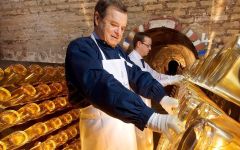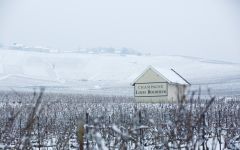Louis Roederer Cristal Brut (1.5 Liter Magnum) 2012
-
Wine
Enthusiast -
Wine
Spectator -
Robert
Parker -
James
Suckling -
Wine &
Spirits



Product Details
Your Rating
Somm Note
Winemaker Notes
2012 was one of the most challenging and complicated years ever experienced in Champagne. However, difficult conditions often lead to great things… The low yields, due to the unpredictable weather, combined with continental conditions towards the end of the season, gave us unusual levels of maturity, resulting in rich, full-bodied and structured wines worthy of the greatest vintages in Champagne.
Rich and complex aromas with notes of zesty and candied fruit (lemon) mingled with pollen (white flowers), roasted hazelnut and Madagascar vanilla. After aeration, the bouquet develops rich notes of fresh pastries and smoky notes from bottle ageing.
A delicious, concentrated and chalky palate. It shows incredible tension and perfectly honed aromatic precision. The attack is powerful, distinctive and concentrated and reveals a silky, mouth-coating texture, characteristic of the ripe Pinot noirs from the 2012 vintage.
Professional Ratings
-
Wine Enthusiast
As the first 100% biodynamic Cristal, entirely from Roederer-owned vineyards, this is an important milestone. This latest incarnation is a great Champagne with its density, elegance and poise. Still impressively young, the wine is taut, tightly wound and textured. At the same time, it has pure, ripe white and citrus fruits that are perfumed, and an important part of this wine’s long-term future. Drink at the earliest from 2023.
Cellar Selection -
Wine Spectator
A classic beauty, fresh-faced and focused today but with a harmonious grace of form suggesting a long career ahead. There's a creamy, viscous quality to the mousse that swathes the palate, carrying finely detailed flavors of poached quince, Mandarin orange preserves, toasted almond and pickled ginger. Mouthwatering throughout, with a pleasing, soft zestiness to the mineral-laced finish. Drink now through 2035.
-
Robert Parker's Wine Advocate
Aromas of clear honey, crisp green orchard fruit, white peach, pastry cream and dried white flowers introduce the 2012 Cristal, a full-bodied, concentrated and powerful wine that's built for the cellar. Broader, more textural and more muscular than the 2008 Cristal, with seemingly even greater reserves of structuring dry extract, the 2012 is incisive and searingly chalky. This is the first Cristal produced exclusively from organically farmed fruit, and it marks the opening of a new chapter for Louis Roderer. The blend is 60% Pinot Noir and 40% Chardonnay, vinified without malolactic fermentation and disgorged with 7.5 grams per liter dosage. Chef de Caves Jean-Baptiste Lecaillon has once again excelled himself. Rating: 97+
-
James Suckling
The second bottle of this that was opened was more expressive than the first one. Fragrant nose of lime zest, dried flowers, fresh almonds and flint. Bright and juicy on the quite firm, medium- to full-bodied palate. This is now in the no-man’s-land between youthful vitality and mature patina, and this really expanded after some aeration in the glass. Layered structure at the long, linear finish. From the first vintage in which the vineyards were cultivated biodynamically. Tasted at the Cristal vertical tasting at the champagne house on July 6th, 2023.
-
Wine & Spirits
Jean-Baptiste Lécaillon reports that 2012 was the first vin- tage for Cristal in which he and his team had converted all of the vineyards to biodynamics, having achieved that goal for Cristal Rosé in 2007. The purity of this wine sustains the crisp- ness and freshness of a late-summer apple picked directly off the tree. Its layered concentration of chalk and fruit starts out as a tense buzz before it opens to a racy and ethereal flavor, a delicious complex of energy and matter with a long life ahead.
Other Vintages
2015-
Wine
Enthusiast -
Wine &
Spirits -
James
Suckling -
Jeb
Dunnuck -
Wine
Spectator - Decanter
-
Robert
Parker
-
Wine
Spectator -
Jeb
Dunnuck -
Wine
Enthusiast -
Wilfred
Wong -
James
Suckling -
Robert
Parker - Decanter
-
Australian Wine
Companion -
James
Suckling -
Robert
Parker - Decanter
-
Jeb
Dunnuck -
Wine
Spectator -
Wine &
Spirits
- Decanter
-
Wine
Enthusiast -
James
Suckling -
Wine &
Spirits -
Robert
Parker -
Wine
Spectator
-
Jeb
Dunnuck -
James
Suckling -
Wine
Enthusiast -
Robert
Parker -
Wilfred
Wong - Decanter
-
Wine
Spectator
-
Wilfred
Wong -
James
Suckling -
Wine
Enthusiast -
Wine &
Spirits -
Wine
Spectator
- Decanter
-
James
Suckling -
Robert
Parker -
Wine
Spectator -
Wine
Enthusiast -
Wine &
Spirits
-
James
Suckling -
Wine
Enthusiast -
Wine &
Spirits -
Wine
Spectator -
Robert
Parker
-
Wine &
Spirits -
Robert
Parker -
Wine
Enthusiast -
James
Suckling -
Wine
Spectator
-
Wine &
Spirits -
Wine
Enthusiast -
James
Suckling -
Connoisseurs'
Guide -
Robert
Parker -
Wine
Spectator
-
Robert
Parker -
Wine &
Spirits
-
Robert
Parker -
Wine &
Spirits -
Wine
Enthusiast
-
Robert
Parker -
Wine &
Spirits
-
Wine &
Spirits -
Robert
Parker -
Wine
Enthusiast
-
Wine &
Spirits -
Wine
Enthusiast
-
Wine
Enthusiast
-
Wine
Spectator
- Decanter
-
Robert
Parker -
Wine
Spectator
-
Wine
Spectator
-
Robert
Parker






Uncompromising Quality
Champagne Louis Roederer was founded in 1776 in Reims, France and is one of the rare family owned companies, which is still managed by the Roederer family. In 1833, Louis Roederer inherited the company from his uncle and renamed the company under his namesake. Under his leadership, the company rapidly grew while remaining true to their philosophy of uncompromising quality. Today, the company is under the helm of Jean-Claude Rouzaud and his son Frédéric who continue to place quality before quantity.
First-Rate Vineyards
Champagne Louis Roederer is one of the only French champagne producers to own nearly 75 percent of the grapes in the most desirable vineyards in the Champagne. The property is located on 450 acres in the finest villages of Montagne de Reims, Côtes des Blancs, and Valleé de la Marne. Each region is selected to produce Chardonnay and Pinot Noir with the elegance needed for perfectly balanced champagne. The Louis Roederer vineyards rate an average 98 percent based on France’s statutory 100-point classification scale.
The reserve wine is then tasted and graded by a team of Roederer specialists. They choose as many as 40 different wines from several lots for the blend. For the final touch, the wine is then added in order to enhance the cuvee and guarantee consistency while retaining the champagne's characteristics.

Representing the topmost expression of a Champagne house, a vintage Champagne is one made from the produce of a single, superior harvest year. Vintage Champagnes account for a mere 5% of total Champagne production and are produced about three times in a decade. Champagne is typically made as a blend of multiple years in order to preserve the house style; these will have non-vintage, or simply, NV on the label. The term, "vintage," as it applies to all wine, simply means a single harvest year.

Associated with luxury, celebration, and romance, the region, Champagne, is home to the world’s most prized sparkling wine. In order to bear the label, ‘Champagne’, a sparkling wine must originate from this northeastern region of France—called Champagne—and adhere to strict quality standards. Made up of the three towns Reims, Épernay, and Aÿ, it was here that the traditional method of sparkling wine production was both invented and perfected, birthing a winemaking technique as well as a flavor profile that is now emulated worldwide.
Well-drained, limestone and chalky soil defines much of the region, which lend a mineral component to its wines. Champagne’s cold, continental climate promotes ample acidity in its grapes but weather differences from year to year can create significant variation between vintages. While vintage Champagnes are produced in exceptional years, non-vintage cuvées are produced annually from a blend of several years in order to produce Champagnes that maintain a consistent house style.
With nearly negligible exceptions, . These can be blended together or bottled as individual varietal Champagnes, depending on the final style of wine desired. Chardonnay, the only white variety, contributes freshness, elegance, lively acidity and notes of citrus, orchard fruit and white flowers. Pinot Noir and its relative Pinot Meunier, provide the backbone to many blends, adding structure, body and supple red fruit flavors. Wines with a large proportion of Pinot Meunier will be ready to drink earlier, while Pinot Noir contributes to longevity. Whether it is white or rosé, most Champagne is made from a blend of red and white grapes—and uniquely, rosé is often produce by blending together red and white wine. A Champagne made exclusively from Chardonnay will be labeled as ‘blanc de blancs,’ while ones comprised of only red grapes are called ‘blanc de noirs.’
